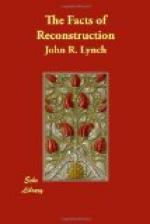I accepted the responsibility, and immediately proceeded with the work of drafting a bill for that purpose. Two plans had been discussed, each of which had strong supporters and advocates. One plan was so to apportion the State as to make all of the districts Republican; but in doing so the majority in at least two of the districts would be quite small. The other was so to apportion the State as to make five districts safely and reliably Republican and the remaining one Democratic. I had not taken a decided stand for or against either plan. Perhaps that was one reason why the advocates of both plans agreed to refer the matter to me for a final decision.
The Democrats heard what had been done. One of them, Hon. F.M. Goar, of Lee County, called to see me so as to talk over the matter. He expressed the hope that in drawing up the bill, one district would be conceded to the Democrats.
“If this is done,” he said, “I assume that the group of counties located in the northeastern part of the State will be the Democratic district. In that event we will send a very strong and able man to Congress in the person of Hon. L.Q.C. Lamar.”
I had every reason to believe that if Mr. Lamar were sent to Congress he would reflect credit upon himself, his party, and his State. I promised to give the suggestion earnest and perhaps favorable consideration. After going over the matter carefully I came to the conclusion that the better and safer plan would be to make five safe and sure Republican districts and concede one to the Democrats. Another reason for this decision was that in so doing, the State could be more fairly apportioned. The Republican counties could be easily made contiguous and the population in each district could be made as nearly equal as possible. The apportionment could not have been so fairly and equitably made if the other plan had been adopted.
After the bill had been completed, it was submitted to a joint caucus of the Republican members of the two Houses, and after a brief explanation by me of its provisions it was accepted and approved by the unanimous vote of the caucus.
When it was brought before the house, a majority of the Democratic members,—under the leadership of Messrs. Streeter, Roane and McIntosh,—fought it very bitterly. They contended that the Democrats should have at least two of the six Congressmen and that an apportionment could have been made and should have been made with that end in view. The truth was that several of those who made such a stubborn fight against the bill had Congressional aspirations themselves and, of course, they did not fail to see that as drawn the bill did not hold out flattering hopes for the gratification of that ambition. But it was all that Mr. Goar and a few others that he had taken into his confidence expected, or had any right to expect. In fact, the one Democratic district, constructed in accordance with their wishes,




